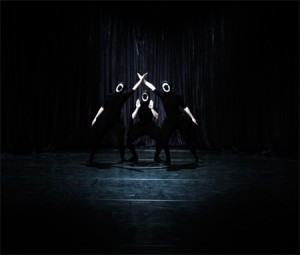Barbara Fenig ’11 reviews the exhibit “Excavations: The Prints of Julie Mehretu.”
 Excavations: The Prints of Julie Mehretu makes the Davison Art Center exhibition gallery radiate with swirls, dashes, dots and splashes of pastel colors. The exhibit is a compilation of twenty prints and is the first comprehensive exhibition from the artist. In the pieces, Mehretu addresses the momentum of civilizations—their inherent creation and inevitable demise.
Excavations: The Prints of Julie Mehretu makes the Davison Art Center exhibition gallery radiate with swirls, dashes, dots and splashes of pastel colors. The exhibit is a compilation of twenty prints and is the first comprehensive exhibition from the artist. In the pieces, Mehretu addresses the momentum of civilizations—their inherent creation and inevitable demise.
The works read like fossils, which showcase the creature that once was and its disintegrating present, a diminished shadow of its former self. But unlike fossils, Mehretu’s prints are alive with animated, colorful details. These layered portraits showcase glimpses of city-grids, skyscrapers, rivers, mountains, maps, and weather charts. The images take on voluminous shapes, curling lines, dashes, and vibrant colors to accentuate Mehretu’s study of “the interconnectedness and entropy of modern civilization.” The artist is at once showcasing the evolution of cities, and therefore civilization, while also dismantling the premises of human society. As she adds to the prints, Mehretu’s initial base for the piece—the city grids or weather charts or skyscraper architectural renderings—become enveloped, and often even erased, by cloudlike markings. This layered collage requires the reader to examine each piece countless times before absorbing the artist’s full intention.
Born in Addis Ababa, Ethiopia, Mehretu grew up in East Lansing, Michigan; she has lived around the world in Michigan, Rhode Island, Senegal and New York City. She began printmaking while in a graduate program at the Rhode Island School of Design. Mehretu has delved into various printmaking techniques, including lithography, screen-printing, and chine collé, and uses various types of paper, such as gampi paper, in the exhibit. While viewing Excavations: The Prints of Julie Mehretu, it is evident that Mehretu has thought about each aspect of the piece. From her choice for each piece’s materials to the viewer’s final glance at the piece from across the room, the artist has carefully tried to predict the audience’s reaction to her work. And it is this careful consideration that makes each piece so alluring.
Excavations: The Prints of Julie Mehretu is deeply routed in earthly imagery, from mountains to river streams, skyscrapers to clouds. In Landscape Allegories (2004), the viewer first notices what appears to be a volcano—dashes of lava showcase the trauma within the piece. Yet, upon further examination, the viewer sees the world moving past the volcano and watches the landscape heal. The piece at once emphasizes the catastrophe and the reconciliation. Mehretu is ultimately showing the passage of time, crystallized in each portrait.
Many of Mehretu’s pieces in the exhibit do not use color. When the artist does incorporate color, Mehretu asks her audience to uncover this special meaning within each dot, line, or swirl of color. The viewer ponders whether that orange circle is in fact representative of the sun, or an orange, or some other shape entirely unimaginable before viewing the piece.
When visiting the exhibit, it is important to examine each piece from different distances. Just as Mehretu layers details, sometimes illuminating them and sometimes hiding them, the viewer must inspect each piece in various ways. Rogue Ascension (2002) is the ideal example of this. The piece has an undertone of peach clouded strokes. From afar, the viewer might think that this has been painted on top or within the print; however, the peach layer is actual buried beneath the print, an under-layer—like a fossil—, and viewable through a blurred sheet. Up close, the peach is barely visible, yet from across the room it beams forth demanding attention.
Excavations: The Prints of Julie Mehretu runs through December 11, 2011. The Davison Art Center is open from noon to 4pm Tuesday through Sunday. Admission is free.


